Gallery
- Facade of church
- belltower
- Romanesque apse
- Interior of church
San Michele Arcangelo is a romanesque-style Roman Catholic church in the city of Potenza, region of Basilicata, Italy.
A church at the site is first documented in 1178, however, floor mosaics, likely from the 5th century, uncovered in the church suggest that a late Roman structure was likely here before then. As was common for many Lombard churches, it was dedicated to St Michael Archangel. The stone portal has a sculpted relief of the Madonna and Child with some Franciscan Order symbols. [1]

Romanesque architecture is an architectural style of medieval Europe that was predominant in the 11th and 12th centuries. The style eventually developed into the Gothic style with the shape of the arches providing a simple distinction: the Romanesque is characterized by semicircular arches, while the Gothic is marked by the pointed arches. The Romanesque emerged nearly simultaneously in multiple countries ; its examples can be found across the continent, making it the first pan-European architectural style since Imperial Roman architecture. Similarly to Gothic, the name of the style was transferred onto the contemporary Romanesque art.
San Lorenzo is the Italian and Spanish name for Saint Lawrence, the 3rd-century Christian martyr, and may refer to:

Forenza is a town and comune in the province of Potenza, Basilicata, southern Italy. It is bounded by the comuni of Acerenza, Avigliano, Filiano, Ginestra, Maschito, Palazzo San Gervasio, Pietragalla, Ripacandida.

Acerenza is a town and comune in the province of Potenza, in the Southern Italian region of Basilicata. It is one of I Borghi più belli d'Italia.

Rapolla is a town and comune in the province of Potenza, in the Southern Italian region of Basilicata. It is bounded by the comuni of Barile, Lavello, Melfi, Rionero in Vulture, Venosa.

Acqui Terme is a city and comune in the province of Alessandria, Piedmont, northern Italy. It is about 35 kilometres (22 mi) south-southwest of Alessandria. It is one of the principal winemaking communes of the Italian DOCG wine Brachetto d'Acqui.

Romanesque art is the art of Europe from approximately 1000 AD to the rise of the Gothic style in the 12th century, or later depending on region. The preceding period is known as the Pre-Romanesque period. The term was invented by 19th-century art historians, especially for Romanesque architecture, which retained many basic features of Roman architectural style – most notably round-headed arches, but also barrel vaults, apses, and acanthus-leaf decoration – but had also developed many very different characteristics. In Southern France, Spain, and Italy there was an architectural continuity with the Late Antique, but the Romanesque style was the first style to spread across the whole of Catholic Europe, from Sicily to Scandinavia. Romanesque art was also greatly influenced by Byzantine art, especially in painting, and by the anti-classical energy of the decoration of the Insular art of the British Isles. From these elements was forged a highly innovative and coherent style.

Aubigné-Racan is a commune in the Sarthe department in the region of Pays de la Loire in north-western France.

Potenza is a comune in the Southern Italian region of Basilicata.
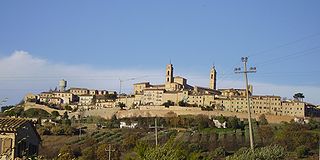
Montecosaro is a comune (municipality) in the Province of Macerata in the Italian region Marche, located about 35 kilometres (22 mi) southeast of Ancona and about 15 kilometres (9 mi) east of Macerata.
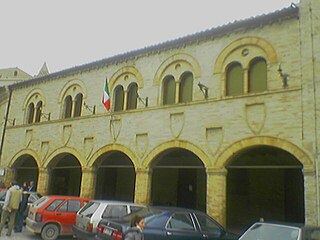
Montelupone is a comune (municipality) in the Province of Macerata in the Italian region Marche, located about 30 kilometres (19 mi) south of Ancona and about 11 kilometres (7 mi) northeast of Macerata.

Potenza Picena is a comune (municipality) in central Italy, situated in the Province of Macerata, in the Marche region. It has 15,503 residents.

A tympanum is the semi-circular or triangular decorative wall surface over an entrance, door or window, which is bounded by a lintel and an arch. It often contains pedimental sculpture or other imagery or ornaments. Many architectural styles include this element, although it is most commonly associated with Romanesque and Gothic architecture.
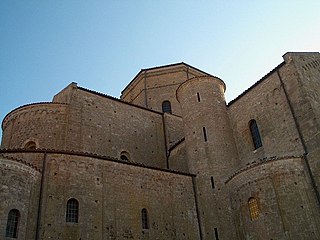
Acerenza Cathedral is a Roman Catholic cathedral dedicated to the Assumption of the Blessed Virgin Mary and to Saint Canius in the town of Acerenza, in the province of Potenza and the region of Basilicata, Italy. It is the seat of the Archbishop of Acerenza. It was declared a minor basilica in 1956.

Arles, Roman and Romanesque Monuments is an area containing a collection of monuments in the city centre of Arles, France, that has been listed as a UNESCO World Heritage Site since 1981.

Septempeda was a Roman town in Picenum located near the modern San Severino Marche, Marche, Italy.

The Church of St. Joachim was a Catholic parish church under the authority of the Archdiocese of New York, located at 26 Roosevelt Street, in Manhattan, New York City.
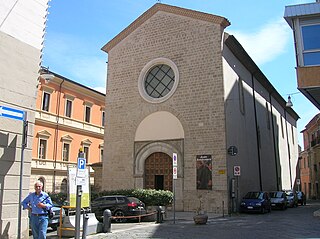
San Francesco is a romanesque-Gothic-style Roman Catholic church in the city of Potenza, region of Basilicata, Italy.
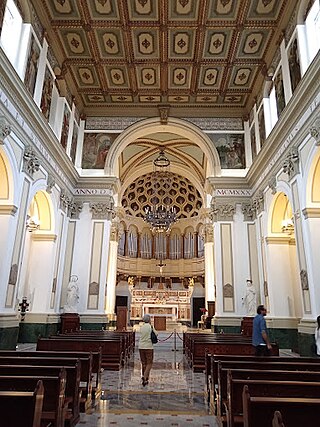
Santissima Trinità is a Romanesque-revival church located on Via Pretoria 123 in the city of Potenza, Basilicata, Italy. The church is now infamous as the seventeen year hiding place of the body of Elisa Claps, a young woman murdered by Danilo Restivo in 1993. The parish priest at the time of Claps's disappearance had denied the police permission to search the church despite it having been the last place where the young woman had been seen alive. The church was only searched after Restivo was arrested in England for the murder of Heather Barnett.

Marsico Nuovo Cathedral is a Roman Catholic cathedral, dedicated to the Assumption of the Virgin Mary and Saint George, in the town of Marsico Nuovo, province of Potenza, region of Basilicata, Italy. It stands on a hill that rises above the town. Formerly the seat of the diocese of Marsico Nuovo, it has been a co-cathedral within the Archdiocese of Potenza-Muro Lucano-Marsico Nuovo since 1986.